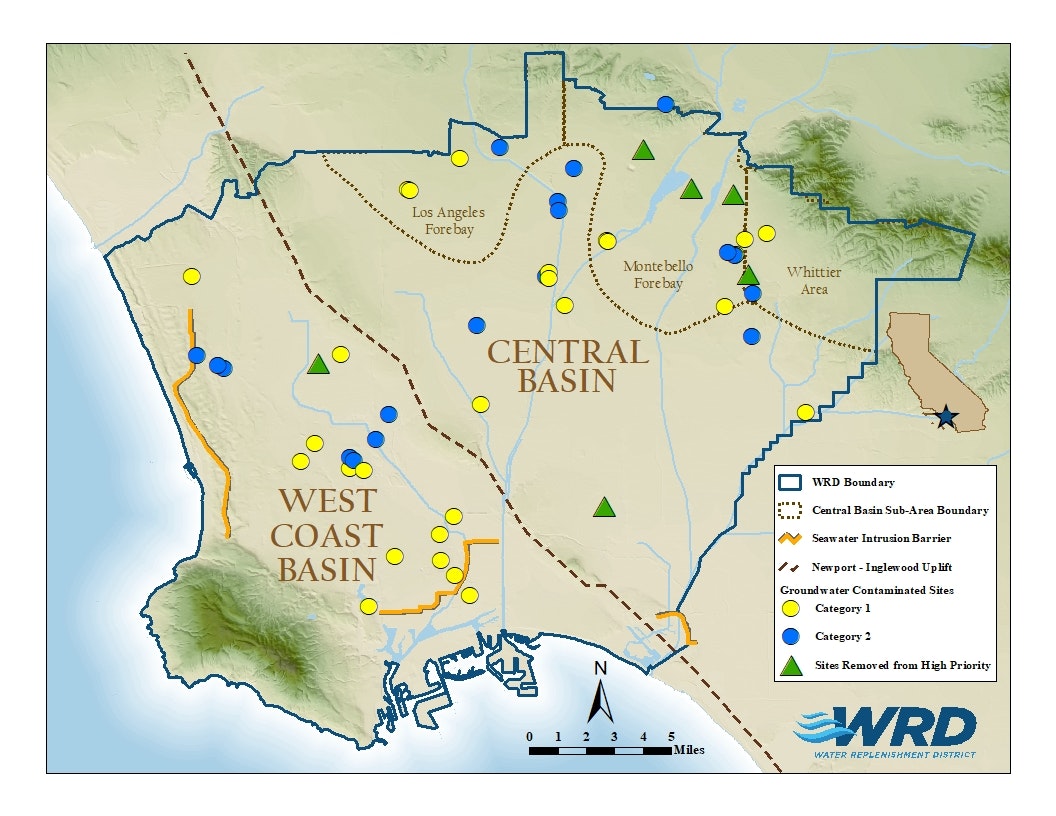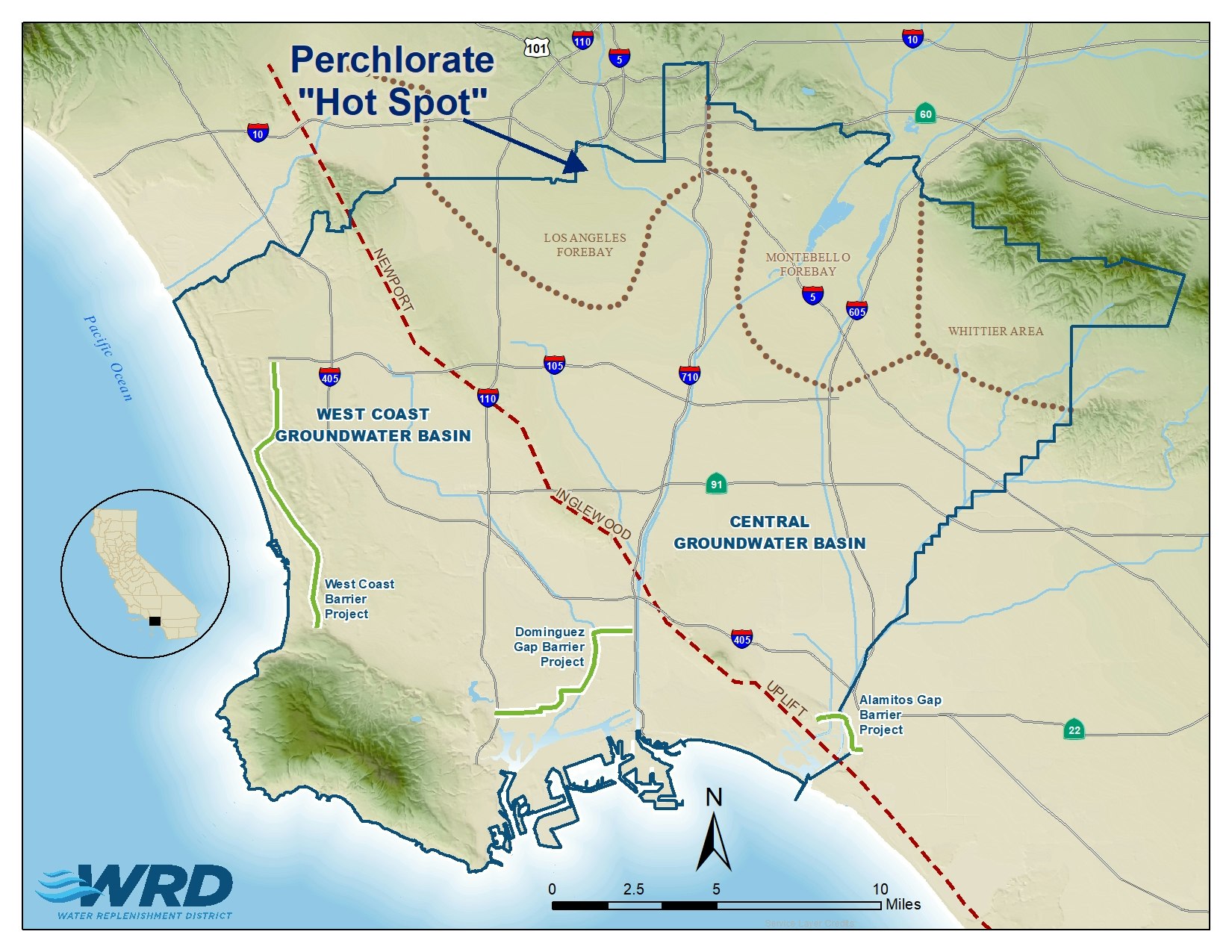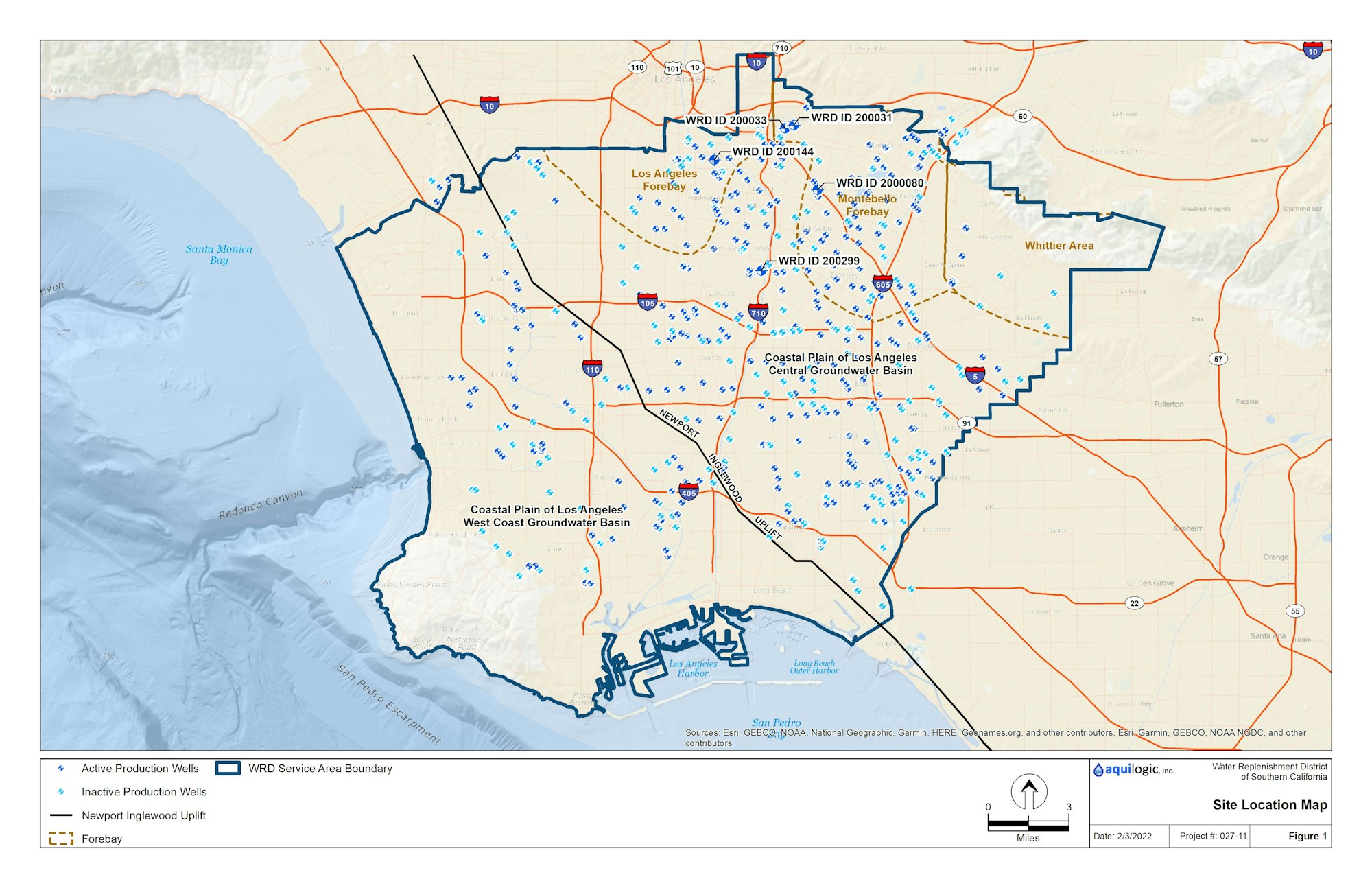Groundwater Contamination Prevention Program

PROGRAM BACKGROUND
The Water Replenishment District's mission is to "provide, protect, and preserve safe and reliable high-quality groundwater." To help achieve this mission, the Groundwater Contamination Prevention Program was established to identify areas of existing or potential groundwater contamination and address them through collaborative mitigation efforts. There are several components of the Groundwater Contamination Prevention Program including a Groundwater Contamination Forum that monitors high priority contamination sites, the Perchlorate Cleanup Program which addresses a particular perchlorate plume, and the Well Destruction Program which works to eliminate the spread of contamination through inactive water supply wells. Taken together, these programs and projects help protect and improve the water quality of the groundwater basins and strengthen the partnerships that we have with water stakeholders in the WRD service area.
WRD established the Central and West Coast Basin Groundwater Contamination Forum, a data-sharing and discussion forum with key stakeholders.

The Water Replenishment District (WRD) continues to take an active role in groundwater quality protection, cleanup, and investigation. As part of its Groundwater Contamination Prevention Program, WRD established the Central and West Coast Basin Groundwater Contamination Forum, a data-sharing and discussion forum with key stakeholders that include various cities, water purveyors, the United States Environmental Protection Agency (EPA), California Department of Toxic Substances Control (DTSC), Los Angeles Regional Water Quality Control Board (RWQCB), State Water Resources Control Board Division of Drinking Water (DDW), United States Geological Survey (USGS), and California Department of Water Resources (DWR).
In 2005, the stakeholders drafted and signed a Memorandum of Understanding (“MOU”) agreeing to meet regularly and share data on major groundwater contaminated sites within the Central Basin and West Coast Basin. WRD acts as the meeting coordinator and data repository/distributor, helping stakeholders to characterize the extent of contamination to identify pathways for contaminants in shallow aquifers to reach deeper drinking water aquifers and develop optimal methods for remediating contaminated groundwater. The overall purpose of the Forum is to expedite the cleanup of these major contaminated sites in the basins.
With the cooperation and support of all stakeholders in the Groundwater Contamination Forum, WRD developed a list of high-priority groundwater contaminated sites (“environmental sites”) located within the District. This list is a living document, subject to cleanup and “closure” of sites, as well as discovery of new sites warranting further attention.
To better understand how High Priority Sites are identified and categorized, please read the AWWA California-Nevada Section Winter 2019 Source Newsletter.
AWWA Source Newsletter - 2019 (PDF).pdfWRD is currently investigating and will be cleaning up perchlorate in groundwater

PROJECT BACKGROUND
The Water Replenishment District (WRD) is currently investigating and will be cleaning up perchlorate in groundwater with the assistance of various regulatory agencies in association with our Los Angeles Forebay Groundwater Task Force. The perchlorate concentrations detected in groundwater are among the highest in the state and the impacted groundwater is currently located in a deep aquifer system within the Los Angeles Forebay. This is a particularly sensitive area of the basin as the groundwater (along with contaminants) can migrate through the coarse-grained sediments directly into the regional aquifer system representing a substantially imminent threat to the Central Basin and West Coast Basin (or CBWCB). In fact, perchlorate has already been detected at elevated levels and is currently having to be addressed in at least two municipal water supply wells. The source of the perchlorate is unknown and a responsible party (RP) has not been identified by the either the Department of Toxic Substances Control (DTSC) or Los Angeles Regional Water Quality Control Board (LARWQCB).
WRD successfully applied for and received a grant for over $7 million from the State Water Resources Control Board (SWRCB) through the Proposition 1 Groundwater Grant Program (Proposition 1). The State grant funds will help pay for approximately 80% of the cleanup construction costs to address the perchlorate impacts along with other comingled volatile organic compounds (VOCs). In 2022, a groundwater extraction and treatment system was installed and operations began, to immediately reduce contaminant concentrations within the perchlorate "hot spot" to help prevent any further migration into the CBWCB. Additional data will be collected during the investigation phase to help support the various regulatory agencies in identifying the perchlorate source and yet to be determined RP.
PROJECT TIMELINE & MILESTONES

WRD has already conducted an extensive amount of work to identify and address the contamination issues in the Los Angeles Forebay. In 2015, WRD constructed three deep-nested groundwater monitoring wells to delineate the occurrence of perchlorate in the City of Vernon. In 2016, WRD analyzed perchlorate remedial technologies and prepared cost estimates with the assistance of their on-call environmental consultant WorleyParsons. WRD submitted a grant proposal for the project on November 18, 2016. A preliminary grant award was issued on March 30, 2017. The grant agreement was signed by the State Water Board on November 21, 2018.
PROJECT GOALS & DESIRED OUTCOMES
The project goals, desired outcomes, and project lifetime are summarized as follows:
- Performance Measure #1: Water That Is Prevented from Becoming Contaminated
The goal is to reduce the overall area of the perchlorate ‘hot spot’ through the installation of a groundwater extraction and treatment system capable of reducing the overall area by 90% and prevent the migration of perchlorate to municipal supply wells and concurrently treat other regional constituents like VOCs. By reducing the area of perchlorate, less mass will be available for migration to municipal water supply wells in and around the City of Vernon.
- Performance Measure #2: Mass Removal Target
The goal is to remove an estimated one thousand (1,000) pounds of perchlorate mass from groundwater in the vicinity of the ‘hot spot’ at monitoring well MW-03. Samples will be collected from the groundwater treatment system to calculate mass removal for the Project. The removal of perchlorate mass from the aquifer system will have a beneficial effect and prevent ‘hot spot’ concentrations from migrating to municipal water supply wells.
- Performance Measure #3: Number of Contaminated or Threatened Municipal Wells That Will No Longer Be Contaminated or Threatened
The goal is to protect drinking water supplies and enhance local water supply reliability by remediating the perchlorate ‘hot spot’ in and around monitoring well MW-03. Our desired outcome is the protection of 13 municipal water supply wells (defined above in Section I.B).
- Performance Measure #4: Percent Reduction in Concentration of the Contaminant
The goal is to significantly reduce perchlorate concentrations in the ‘hot spot’ which is defined by an area containing perchlorate concentrations exceeding 1,000 µg/L as defined in the grant submittal to the SWRCB with the highest perchlorate concentrations centering around groundwater monitoring well MW-03. It is estimated the groundwater extraction and treatment system can reduce the perchlorate concentration in this well by 98%.
Additional info is provided in the Project Assessment & Evaluation Plan available:
PROJECT LINKS
- Link to project documents via GeoTracker:
https://geotracker.waterboards.ca.gov/profile_report?global_id=T10000012353
- Link to Proposition 1:
- EPA website for discussing Perchlorate:
https://www.epa.gov/dwstandardsregulations/perchlorate-drinking-water
- Downloadable WRD Vernon Perchlorate Fact Sheet
WRD is currently working on a well destruction program to decrease the potential threat of contaminants moving into and impacting the water quality in aquifers

PROJECT BACKGROUND
The Water Replenishment District (WRD) is currently working on a well destruction program to help eliminate the potential threat of contaminants entering five inactive water supply wells and moving into and impacting the water quality in aquifers. These wells have outlived their useful lives and may act as a conduit potentially allowing contamination to migrate between various aquifers with the deepest wells screened to over 1,000 feet below ground surface (ft bgs). Properly destroying inactive wells in the Central Basin and West Coast Basin (CBWCB) will help ensure the protection of those aquifers, which is one of WRD’s key missions.
WRD successfully applied for and received a grant for approximately $844 thousand from the State Water Resources Control Board (SWRCB) through the Proposition 1 Groundwater Grant Program (Proposition 1). The state grant funds will help pay for a majority costs (approximately 80%) to properly destroy five inactive water supply wells located in the Central Basin. In 2022, the five inactive water supply wells will be properly destroyed to eliminate the potential conduits and to help prevent any further migration into the CBWCB.
PROJECT GOALS & DESIRED OUTCOMES
The project goals, desired outcomes, and project lifetime are summarized as follows:
- Performance Measure #1: Water that is prevented from becoming contaminated
The goal is to eliminate the potential migration of impacted groundwater through the production well into deeper aquifers present with the Central Basin and West Coast Basin. By increasing the number of water supply wells to be destroyed, additional water supplies will be protected from being contaminated. Through the destruction of inactive water supply wells, the potential pathway(s) for contamination to migrate into drinking water aquifers will be eliminated and less contamination will be introduced to drinking water aquifers through these destroyed inactive water supply wells. As such, less contamination will be present within drinking water aquifers that can subsequently migrate and contaminate other drinking water sources within the community.
- Performance Measure #2: Number of Contaminated or Threatened Municipal Wells That Will No Longer Be Contaminated or Threatened
The goal is to protect drinking water supplies and enhance local water supply reliability by eliminating inactive production wells that may allow contaminant migration into the deeper aquifers of the Central Basin. Our desired outcome is the protection of production wells located hydraulically downgradient as identified in each Well Location Report.
PROJECT LINKS
- Link to project documents via GeoTracker:
https://geotracker.waterboards.ca.gov/profile_report?global_id=T10000016848
- Link to Proposition 1.
